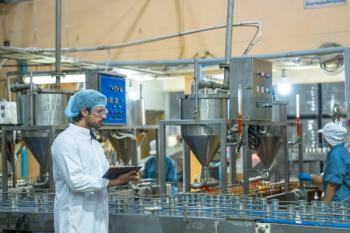Key Points
- Researchers from the U.S. Horticultural Research Laboratory identified “baseline fractions” in citrus peel aqueous extracts that cause elevated broad high performance liquid chromatography (HPLC) baselines, finding that these fractions contain water-soluble proteins and methanol-soluble suberin polymers.
- Suberin, a structural plant polymer found in citrus peels, can reduce the proportion of flavanone glycosides in peel extracts and may contribute to the biological effects of flavonoid-enriched citrus peel supplements.
- The water-soluble component of these baseline fractions was determined to be protein as determined by Fourier-transform infrared (FTIR) spectroscopy; the remaining major components of these baseline fractions were freely soluble in methanol, and the FTIR and nuclear magnetic resonance (NMR) spectra of these components were indicative of the plant polymer, suberin
Traditionally, flavanone glycosides have been recovered from citrus peels and commercialized as herbal supplements. A consistent feature of high-performance liquid chromatography (HPLC) chromatograms of such aqueous peel extracts is significantly elevated broad baselines, which suggest the occurrence of wide populations of possibly similar chemical entities. Researchers from the U.S. Horticultural Research Laboratory’s Agricultural Research Service (Fort Pierce, Florida) isolated these materials to recover what was termed “baseline fractions” enriched in the peel materials responsible for these elevated baselines. The goal of their study was the isolation of the material responsible for these elevated baselines for the performance of an initial chemical characterization and possible identification of this portion of citrus peel water extracts. A paper based on their work was published in the Journal of the Science of Food and Agriculture (1).
Numerous potentially health-benefiting compounds are abundant in citrus peels; these include primarily flavanone glycosides, hydroxycinnamates, and polymethoxylated flavones (2,3) The scale recoveries of these compounds typically involve initial aqueous peel extractions, which creates a material similarly produced as a by-product in juice production referred to as “peel juice,” made up of soluble sugars (60–70% of the dry weight), suspended tissue fragments, non-dialyzable solids (proteins), organic acids, mineral ions, phenolic compounds, polyols, and other components such as limonoids (4,5). Peel juice may then be passed through an anion-exchange resin to remove a significant amount of the pectin typically contained in this extract and then be passed again through adsorbent resins for the removal of free sugars and other cell wall polysaccharides in the column washes, and to finally salvage the assortment of peel phenolics through ethanolic washes of the exposed resins (5,6).
Suberin, an important structural component of plant cell walls, plays an important part in plant growth and development (7). Its presence represents an undescribed peel component commonly occurring in citrus peel flavonoid supplements consistently lowered the percent composition of commercially recovered citrus peel flavonoids, particularly the flavanone glycosides hesperidin and narirutin in orange and mandarin peels, naringin in grapefruit peel, and eriocitrin in lemon and lime peels (1). While there have been efforts toward the recognition and validation of citrus fruits’ health benefits in general (and of citrus peel waste in particular) (8-12), less is known about possible impacts of suberin on human health (13). Speculation of the feasibility of suberin monomers being bioactive in flavanone-enriched citrus peel supplements influenced the researchers to embark on this study.
According to the authors, the water-soluble component of these baseline fractions was determined to be protein as determined by Fourier-transform infrared (FTIR) spectroscopy. The remaining major components of these baseline fractions were freely soluble in methanol, and the FTIR and nuclear magnetic resonance (NMR) spectra of these components were indicative of the plant polymer, suberin. Size exclusion chromatography showed this material to largely occur between 10 and 60 kDa as would be expected for this plant polymer (1).
The researchers propose in their study that suberin is responsible for the broad elevated HPLC baselines of citrus extracts. In addition, this multifunctional chemical cell wall material may possibly contribute to the overall biological effects attributed to flavanone-enriched citrus peel supplements, in which this material frequently occurs.
Future work could include the identification of suberin monomers via gas chromatography-mass spectrometry (GC–MS) analysis following a depolymerizing methanolysis, which would provide additional validation of the presence of suberin. Furthermore, since aqueous extracts are utilized as flavonoid-enriched citrus peel supplements, future biological tests of these flavonoid-enriched citrus peel components could consider possible contributions of suberin to these examinations. In addition, after testing for the presence of suberin, future research could be directed toward the understanding of any potentially occurring health benefits of this material. While it needs to be validated in the future, the techniques described in their paper suggest that the obtaining of higher purity flavonoid fractions can be possibly achieved through the removal of suberin and other higher molecular weight peel components by ultrafiltration (1).
References
- Manthey, J. A.; Jeffries, K. A. Suberin. A Component of Citrus Peel Extracts. J. Sci. Food Agric. 2025.DOI: 10.1002/jsfa.70075
- Manthey, J. A. Fractionation of Orange Peel Phenols in Ultrafiltered Molasses and Mass Balance Studies of Their Antioxidant Levels. J. Agric. Food Chem. 2004, 52 (25), 7586-7592. DOI: 10.1021/jf049083j
- Gómez-Mejía, E.; Rosales-Conrado, N.; León-González, M. E. et al. Citrus Peels waste as a Source of Value-Added Compounds: Extraction and Quantification of Bioactive Polyphenols. Food Chem. 2019, 295, 289-299. DOI: 10.1016/j.foodchem.2019.05.136
- Braddock, R. J. Handbook of Citrus by-Products and Processing Technology; Wiley, 1999.
- Grohmann, K.; Manthey, J. A.; Cameron, R. G. Purification of Citrus Peel Juice and Molasses. J. Agric. Food Chem. 1999, 47 (12), 4859-4867. DOI: 10.1021/jf9903049
- M'hiri, N.; Ioannou, I.; Ghoul, M. et al. Phytochemical Characteristics of Citrus Peel and Effect of Conventional and Nonconventional Processing on Phenolic Compounds: A Review. Food Rev. Intl. 2016, 33,587–619 (2016). DOI: 10.1080/87559129.2016.1196489
- Kosma, D. K.; Graça, J.; Molina, I. Update on the Structure and Regulated Biosynthesis of the Apoplastic Polymers Cutin and Suberin. Plant Physiol. 2025, 197, 653 (2025). DOI: 10.1093/plphys/kiae653
- de Castro S. C.; Stanisic, D.; Tasic, L. Sequential Extraction of Hesperidin, Pectin, Lignin, and Cellulose from Orange Peels: Towards Valorization of Agro-Waste. Biofuels Bioprod. Biorefin. 2024, 18, 804–817. DOI: 10.1002/bbb.2606
- Sharma, K.; Mahato, N.; Cho, M. H. et al. Converting Citrus Wastes into Value-Added Products: Economic and Environmently Friendly Approaches. Nutrition 2017, 34, 29-46. DOI: 10.1016/j.nut.2016.09.006
- González-Miquel, M.; Díaz, I. Valorization of Citrus Waste Through Sustainable Extraction Processes, in Food Industry Wastes [Internet]; Elsevier Inc., 2020,pp. 113–133.
- Manthey, J. A. Potential Value-Added Co-Products from Citrus Fruit Processing, in Biorefinery Co-Products: Phytochemicals, Primary Metabolites and Value-Added Biomass Processing; DJC Chantal Bergeron D. J. C. and S Ramaswamy, S. Editors. John Wiley & Sons, Ltd., 2012.
- Tripoli, E.; Guardia, M. L.; Giammanco, S. et al. Citrus Flavonoids: Molecular Structure, Biological Activity and Nutritional Properties: A Review. Food Chem. 2007,104, 466–479. DOI: 10.1016/j.foodchem.2006.11.054
- Acurio-Cerda, K.; Keloth, R.; Obewhere, O. A. Lignin-Based Membranes for Health, Food Safety, Environmental, and Energy Applications: Current Trends and Future Directions. Curr. Opin. Chem. Eng. 2025,47, 101098. DOI: 10.1016/j.coche.2025.101098






